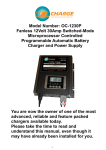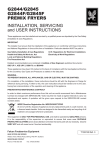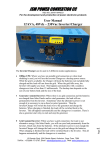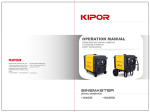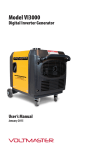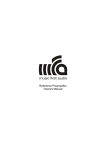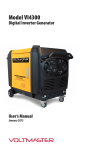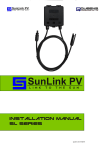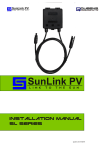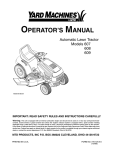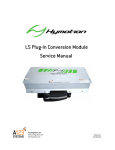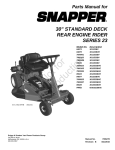Download Leisure Hovercraft - Safety and Reliability
Transcript
Leisure Hovercraft - Safety and Reliability Hovercraft Safety & Reliability v1.01 ©John Robertson 2010 This is a personal view of the current reliability performance of cruising leisure hovercraft - you may not agree with some of the points made but all I ask is that you examine the real-world evidence before reaching your own conclusions. The overriding concern of this review is the protection of the lives of hovercraft operators and their passengers. Everyone who operates, or is a passenger in a hovercraft is totally dependent on the reliability and safety performance of the craft. This review is not concerned with which craft is best, fastest, nicest looking, etc . It is a sad fact that, despite many decades of development, the reliability record of leisure hovercraft (both manufactured AND home/plan built) is absolutely appalling. It would be surprising if the MTBF (mean/average time between failure) of most craft is more than about 4 hours. This failure rate would be completely unacceptable for any other type of machine! Would you be satisfied if your car or washing machine would only run for a few hours before needing repaired? The critically important difference between a washing machine (or a car) failure and a hovercraft failure is that your life depends on the reliability and safety of your hovercraft – you can't get out and walk away from a disabled hovercraft when on water! Whilst the safety record of cruising hovercraft may appear to be good, this is largely an illusion - it only appears good because the poor reliability has limited the exposure to risk – usually the craft has broken down long before the owner can get into any kind of high risk situation! Just because you have bought a shiny new manufactured hovercraft doesn't mean that it is automatically going to be reliable – unfortunately most “commercially” built leisure hovercraft fall far below the standard required for reliable marine operation. In particular, the quality of the design and manufacture of the electrical systems on leisure hovercraft is woefully inadequate and, in some cases, downright dangerous. New owners are being put at risk by elementary defects. I make no apology for this statement but instead offer a challenge to UK hovercraft manufacturers – prove that your craft are designed and manufactured to established marine standards and then demonstrate the reliability and safety with properly researched field test data and I will happily retract this criticism. After all this negativity I believe that it is possible to significantly improve the reliability of a craft by taking a few very simple steps. Hovercraft Safety & Reliability v1.01 ©John Robertson 2010 Part 1: Engine Reliability Most small leisure hovercraft are very simple machines. The most complex part of any hovercraft is the engine (the steering and fan/prop drive systems are the only other moving parts and are normally pretty basic). The most common engine type in current use is an air-cooled industrial engine (Briggs & Stratton, Kohler, Tecumseh, etc) – renowned for their longevity and reliability. The obvious question is, when fitted to a hovercraft, why is it that industrial engines seem to be so unreliable? There are a few reasons for this but the most obvious one is the environment in which they are operated – water – and it's effect on the electrical and fuel systems. These engines can all be relatively easily “marinised” (made to work under very wet conditions) and can become very reliable in a marine environment if a few fairly simple precautions are taken. All any petrol engine needs to operate is fuel, air, a bit of compression and a spark to ignite the mixture. If you have all of these things then, unless it has suffered a catastrophic mechanical failure, it WILL work - and continue to work. First of all, resist the temptation to “tune” or adjust your engine to increase the power output. Industrial engines are designed specifically to operate 24/7/365 – if you overload or over-rev them then you will shorten their life expectancy and increase the risk of failure (most industrial engines have a specified continuous operating RPM, make sure you know what it is - it is almost always less than 3600rpm!). Your engine MUST be able to operate reliably when subjected to heavy water spray! Your craft WILL get wet and your engine WILL get water spray even if your have an engine cover (it's an aircooled engine and the incoming cooling air contains water vapour and droplets). The images shown below are of a Briggs & Stratton 35HP engine – your engine may not look exactly the same so you might need to consult the repair manual Hovercraft Safety & Reliability v1.01 ©John Robertson 2010 to locate of the various components mentioned. Even if your engine isn't an industrial air-cooled type you can still use most of the advice given below to improve the reliability of your hovercraft engine. Note that some of the modifications shown below may void any warranty you may have on your engine or craft – if this is a concern then please check with your supplier before carrying out any of this work Fuel: Make ABSOLUTELY sure you have a good quality fuel filter fitted (fitted as near to the engine end of the fuel pipe as possible and ideally in a horizontal position) and that it is replaced at least once per year. Make sure that your fuel tank vent or filler is not going to allow water into your tank (ideally, fit a small water separator unit in the fuel line). When refuelling, take great care to make sure that the fuel you use is as clean as possible (don't refuel in a dusty parking lot or on a windswept sandy beach). Remove the fuel cut off solenoid from the carburettor – this device is not needed for hovercraft use and has an unacceptably high failure rate. This device is normally found at the base of the carburettor (see below) and often acts as the float bowl drain (it will have two wires connected to it). Vanguard engine anti-afterfire solenoid Intek engine solenoid Failure of this device will instantly disable the engine. There are two ways to disable this device - you can either cut off the actuator pin (see below) OR remove the entire solenoid and replace it with a small bolt with the same thread. Hovercraft Safety & Reliability v1.01 ©John Robertson 2010 Solenoid with actuator pin Actuator pin removed When replacing a modified solenoid, you do not need to reconnect the wiring to it (it is best to remove the connecting wiring loom altogether to reduce the possibility of failure). Cleanliness is essential when dealing with this part – any grit or debris will be introduced directly into the carburettor, bypassing the fuel filter (causing blockages and poor running or even failure). If you cut the actuator pin then thoroughly clean the solenoid to remove any metal particles before replacing it. When this device is disabled, your engine exhaust may “pop” or backfire just after it has stopped. This is caused by unburnt fuel (it hasn't be burnt because the ignition unit has been disabled to stop the engine) passing through the engine into the silencer during engine spin-down – hot particles in the silencer can then ignite the fuel causing a loud backfire . To minimise this effect, allow the engine run at idle speed for 10-60 seconds or so to allow the silencer to cool before switching it off. Spark: This is by far the most common problem seen with these engines. It does require some work to make it reliable in a marine environment. In most small industrial engines, the spark is generated by a sealed (almost!) ignition module mounted next to the engine flywheel and activated by a magnet embedded in the edge of the flywheel. With a little work, this system will operate happily with no maintenance at all for many years – even in a marine environment! The coil and electronics are encapsulated in resin and need no maintenance. The metal “slices” that make up the “U” core need to be protected with some type of coating (varnish, conformal coating or even paint) to prevent corrosion - which can destroy the unit. First, remove the ignition unit(s) from the engine by taking off the front engine cover Hovercraft Safety & Reliability v1.01 ©John Robertson 2010 Twin ignition system engine You will notice that the metal module “legs” are very close to the flywheel – this gap is critical and needs to be properly set when re-fitting the units. If you do not have feeler gauges available then rotate the flywheel until the embedded flywheel magnet (your metal tools will stick to it) is under the ignition module. Then fold paper or card until it can just be squeezed into the gap. Lay the paper/card aside to use as a spacer when re-installing the units. … unscrew the two bolts holding each unit in place. Ignition module retaining bolts ... and then carefully unplug the connector on the rear and disconnect the thick black spark plug HT cable to remove the unit from the engine. “Kill” terminal connection Hovercraft Safety & Reliability v1.01 ©John Robertson 2010 Thoroughly clean the unit and cables with a solvent (or a small amount of petrol) – observing any necessary safety precautions. Once dry, apply tape over the connector tab to prevent contamination and then spray or coat the metal core and housing with varnish, conformal coating or even a thin layer of high-temperature paint (recommended product is Servisol Plastic Seal 60 available from electronic component suppliers) . It's very important that this coating is continuous. Spray on several thin layers and try not to put too thick a layer on the faces that are next to the flywheel. Leave the protective tape on the connector tab for now. The other area which will need work is the engine stop connector tab (see above). When this tab is connected to the the engine body (earth) it will disable the ignition unit and the engine will stop running. As you can see from above, this tab is very close to an earthed connection (the small tab welded to the metal core just below it) – a droplet of water could quite easily bridge this gap and make the engine stop. To prevent this from happening, you should coat the earth tab on the ignition unit with a layer of sealant (recommend polyurethane based sealant adhesive – Sikaflex, etc). Neatness isn't an issue here – it's far more important that the sealant is gap-free and properly bonded to the surfaces! Hovercraft Safety & Reliability v1.01 ©John Robertson 2010 The HT (High Tension = high voltage) cable that connects the unit to the spark plug also needs some attention. You need to seal the small gaps between the plastic boots and the cable itself at each end of the cable to prevent water getting into the connectors inside. Force a small amount of sealant into the gap between the spark plug boot and the HT cable (if you gently bend the cable away from the boot the gap will open up to make it easier to push some sealant in). Also seal any gaps between the cable and the grommet at the module end. You only need enough to seal about 1-2mm into the boot. Once the sealant has thoroughly dried, coat the entire surface of the cable using the spray coating mentioned above. The wiring connected to the “kill” tab on the ignition module is often poor quality with thin insulation and an uninsulated connector – as this connection is critical to the operation of the engine, it is recommended that you replace the wiring and connector with good quality corrosion resistant types (note that twin cylinder engines, which have two ignition units, usually have diodes embedded in the cable that connects to the units). Hovercraft Safety & Reliability v1.01 ©John Robertson 2010 The diode is clearly visible through the transparent section of the cable (be careful not to damage it!) This connection is usually then routed through the craft to an ignition or engine stop switch mounted near to the front of the craft. Carefully examine the cable routing and make sure that this wire is protected from chafing or damage (see below for more info on protecting wiring) – if it breaks you will be unable to stop the engine - if it gets earthed then the engine will stop working altogether. If you think it unlikely that you will be ejected from your craft or you have a spring-return hand throttle then I would strongly recommend against fitting a lanyard kill switch – failure of this switch (surprisingly common) will instantly disable your craft (maybe at a dangerous moment). Before re-fitting the units to the engine, clean or scrape away your new coating from a small area around each fixing hole on the side that faces the engine - this is to ensure that the unit makes a proper connection to the engine earth. Re-assemble the ignition module(s) to the engine being careful to fit them the correct way round (they are marked “THIS SIDE OUT”). The gap between the module and the flywheel is usually set to 0.008”-0.012” (0.2-0.3mm) for Briggs & Stratton engines (check the service manual for your engine type). Rotate the flywheel until the magnet is directly under the ignition unit then place your feeler gauge (or the folded card/paper you used earlier) over the magnet and allow the magnet to pull the ignition module onto the feeler/paper before tightening the fixing bolts. The spark plug(s): The biggest problem with spark plugs in a marine environment is corrosion of the metal body. In particular, the crimped metal seal between the body and the ceramic insulator rusts and the increased pressure can cause microcracking of the insulator leading to a week or non-existent spark (and a poorly running engine). Some makes of plug seem better than others (from experience, NGK are particularly bad). Keep a close eye on the plug(s) and replace them as soon as you see any sign of rust on the exposed metal body. Hovercraft Safety & Reliability v1.01 ©John Robertson 2010 Air: Engines, in general, will run quite happily with a small amount of water vapour in the intake air, however, the paper air filters used in industrial engines will not tolerant water – they become saturated and restrict the air flow making the engine run badly. When operating in salt water, the water evaporates and can leave the filter blocked with layers of salt particle “dust”. The most effective filters are the large cyclonic types fitted to some Briggs and Kohler engines – they are very efficient at removing moisture and dust. If you have another type of filter then the best option is to protect the intake (the hole(s) where the fresh air gets into the filter housing) from direct water spray by either extending them to a clean-air area using hose or PVC pipe (under the seat is often a good place – but make sure it can't “hoover” up dust and debris from the floor!) OR by fitting small shields (bits of plastic sheet//box/etc attached to the filter casing) to protect the intake from direct water spray. Making the intake air travel vertically upwards or around a sharp bend to get to the air cleaner will use gravity to help remove larger water droplets. Hovercraft Safety & Reliability v1.01 ©John Robertson 2010 General Electrical Wiring: From a safety point of view you need to make sure that all wiring is protected by suitably rated fuse(s) if it is connected (even if indirectly through a switch) to a power source that can supply more current than the wire is rated to handle. For example, 1.5mm2 stranded cable is normally rated at 17amps continuous – it should be protected by a 16amp (the next lowest size fuse) fitted at the power source end of the cable (usually the battery). On a hovercraft fitted with an industrial engine the engine alternator is unlikely to be able to supply more than 20amps or so therefore you might think that if you use 20amp cable and switches there would be no need to fit fuses. However, the starter battery is almost certainly capable of supplying many hundreds of amps – any cable or switch connected directly or indirectly to the battery must be either rated to handle this current (as in the case of the battery to starter motor cable) OR be protected by a fuse. Failure to follow this advice could result in a fire or explosion. Remember that you are sitting in a craft with a large quantity of explosive fuel – often right underneath you! Avoid routing wires next to fuel pipes or fuel tanks or in any enclosed space containing either of these components. Never ever tie-wrap a cable to a fuel pipe! There are various other simple steps that you can take which will help protect electrical wiring from the most common causes of damage – corrosion, abrasion (chafing) and stress fractures. Corrosion Corrosion is basically a chemical reaction of the metallic parts of the electrical system (cable connectors and cable copper cores) with oxygen. The metal parts re-combine with oxygen and try to return to their stable original state (iron oxide (rust!), copper oxide, aluminium oxide, etc). Protecting metallic components from coming into contact with oxygen will prevent corrosion. Corrosion in wiring systems is usually (but not always) most evident in connectors or joints. Less commonly, you can get “creeping” corrosion inside insulated cables that are poorly made or sealed (the corrosion creeps up inside the cable, turning the copper wire into a crumbly green mush as it goes). Exposure to air is less likely to cause problems than exposure to water. Water trapped inside a connector next to a metallic component is likely to remain in contact with it for a considerable time (until it evaporates). Air only contains 20% oxygen whereas water is at least 66% oxygen. The main objective should be to protect connectors from exposure to, and retention of, oxygenrich water. It may seem that the best solution would be to completely seal all connectors using tape or a sealant. Unfortunately, this isn't always the best answer. Even if you could guarantee an air-tight seal, unless you can completely remove all Hovercraft Safety & Reliability v1.01 ©John Robertson 2010 of the air from inside the connector joint then natural temperature changes will cause condensation inside the “sealed” connector and can accelerate corrosion. To minimise corrosion: 1. As corrosion mainly affects joints and connector, the most effective thing you can do is to reduce the number of joints and connectors! Remove any supplied engine connector blocks and directly wire (with heat shrink adhesive filled butt splices if the wires need extending) to the connected devices (switches, etc),. If you need to remove an engine then remaking a few cable joints is a minor issue. 2. Use good quality connectors and cable (preferably marine grade). For individual joints, use soft PVC insulated tin-plated brass bullet connectors (the insulating sleeve is a separate part) rather than spade or tab connectors (the female bullet connector should always be on the “live” side of any connection). Use heat shrink adhesive filled butt splices for cable-to-cable joints. Two-part sleeved bullet connector Heat-shrink adhesive sealed butt splice Don't use colour-coded (red/blue/yellow) pre-insulated terminals – they are not sealed. 3. Do NOT use chocolate/terminal blocks or Scotchlock connectors under any circumstances – they are totally unsuitable! 4. Use good quality switches – the standard lawn tractor-type ignition switches commonly used in hovercraft are not suitable for a marine environment. Switches should be rated IP66 or IP67 (dust sealed and resistant to water spray) and should ideally be fitted in a protected location. Pay attention to the connector terminals on the switches – these are a weak point and need to be sealed – once the switch has been connected, liberally coat the terminals and the connector with a polyurethane sealant (this can make it harder to disconnect a switch but it will make it more reliable) 2. Use a controlled-pressure (ratchet type) crimp tool to produce consistent gas-tight joints that will properly support the wire and insulation (the Hovercraft Safety & Reliability v1.01 ©John Robertson 2010 “pliers” type crimp tools are simply not suitable). Get yourself a good cable stripping tool – using old pliers or a pen knife will damage or overstress the wire strands and ultimately cause stress fractures. 3. Fit connectors in locations protected from direct water spray - or shield them with plastic or a box (do not place them inside a closed box – always make sure there are plenty of ventilation/drain holes on the underside of any box). 4. Mount connectors so that cables enter from below rather than from above – this will help prevent water droplets running down the cables directly into the connector joints. If you are unable to do this then fit a cable tie to the entry wire to re-direct water running down the cable. 5. Regularly treat connectors with a suitable water repellent spray to help disperse any trapped water. Abrasion and Stress: Damage to cable and connectors is usually due to friction caused by mechanical vibration between the cable and the component it is touching or close to. To prevent damage: 1. All wiring MUST be double insulated. The best option is to put all cables inside some form of plastic conduit (corrugated flexi-pipe, PVC water pipe, etc.). You can also spiral wrap wire bundles with a double layer of good quality insulating tape or use commercial cable wrapping. 2. Carefully check your engine and any other components for sharp edges or abrasive surfaces near to cables and either re-route the cable or fit extra protection in this area to the cable or over the edge or surface. Hovercraft Safety & Reliability v1.01 ©John Robertson 2010 The example above shows an HT cable (the lower thick black wire) passing directly over the sharp edge of the metal plate on the left (the green wire, which also passes the edge, already shows signs of abrasion damage on this brand-new engine!) 3. Pay very close attention to the routing of HT (spark plug) leads. Ideally they should be suspended in free air and not touch any metallic part (plastic cable spacers are available to help achieve this). Close proximity of an earthed surface to these very high voltage cables can cause breakdown of the insulation and subsequent failure. 4. Connectors should be supported by attaching them to a solid object (don't leave connectors “dangling” in mid-air in the middle of a cable run). More importantly, the cables entering and leaving the connector MUST be prevented from moving relative to the connector. 5. As detailed above, use good quality crimp terminals (and the proper tools) that correctly support the cable to prevent stress damage. Hovercraft Safety & Reliability v1.01 ©John Robertson 2010 Testing: This is the single most important step! You need to be absolutely certain that your engine will continue to run properly when exposed to heavy water spray. Testing your engine is easy. First, remove any engine cover(s). Start up the engine and allow it to warm up and then set it to a fast idle. Take a garden hose and adjust it to produce a heavy, low-pressure spray (think tropical rainstorm!). Move around the running engine directing the water spray onto the cooling air and air filter intakes, the spark plug area and any wiring, etc. It should be pouring off the engine with water spray being pulled through the thrust fan/prop and starting to fill the hull under the engine. You should deliberately direct sustained spray at the air intake, ignition and spark plug cables and areas. Keep doing this for a four or five minutes while listening for any engine hiccups or misfires. If the engine misfires or stops then you need to identify which area is causing the problem and re-insulate it (see above) or protect it from spray using shielding. This may seem like an extreme test but it is perfectly possible, using the steps detailed above, to protect the engine such that it will continue to operate properly under a deluge of water. It is much better to find and fix any problems on your driveway rather than waiting until it happens out on a rough water way in a rainstorm! Important: In future, don't wash your engine using an engine cleaner or detergent or use a high-pressure power washer – they can remove some of the protective coating you have just spent a lot of time applying! Hovercraft Safety & Reliability v1.01 ©John Robertson 2010 Part 2: Passive Safety These are the “designed-in” safety features of the craft and hull. They may represent your last chance of survival. The absolute minimum requirements are that the craft must remain in a level and stable condition and not take on water when floating with the engine off whilst fully loaded and for an indefinite period of time. It must remain afloat when fully flooded and fully loaded or capsized. If you are unsure whether your craft is capable of doing this then check it yourself or ask the manufacturer or plan supplier – your life may depend on it! The flotation, etc requirement detailed above apply under any water or weather conditions! The designer/manufacture should inform you of the safe normal operating envelope for the craft (they should tell you exactly what water and weather conditions and payload the craft is capable of safely operating in and what the hump performance limits are). Unfortunately a large number of current hovercraft, including some manufactured craft, do not meet these very basic passive safety requirements. In addition, new owners are not informed of the operating envelope - I doubt that some manufacturers are even aware what the performance limitations are. Most small hovercraft have virtually no freeboard (the height between the water and the lowest part of the top of the hull when the craft is floating on water) making them highly vulnerable to flooding and subsequent mechanical failure. This is a potentially life-threatening issue so, for your own safety, you should take great care when operating on rough water (make sure you stay well within the manufacturers operational limits for your craft). Hovercraft Safety & Reliability v1.01 ©John Robertson 2010 Part 3: Active Safety Active safety is really about about what you, as the pilot can do to help protect yourself. Firstly, it is important that you a fully aware of the conditions under which your craft can be safely operated – is it too windy, too rough, etc?. Check with the manufacturer or the plans supplier what the operating envelope is. There are a few basic items of safety equipment that all hovercraft owners should have at all times. Lifejacket: Auto-inflating types are strongly recommended, buoyancy aids or manually inflated types are simply not adequate. A lifejacket is your absolute last line of defence – unless your craft has sunk or is on fire, you should never get into the water - if you have no other choice then a lifejacket will improve your chance of survival. Fire extinguisher: A fire on board any water craft is a life threatening situation simply because you can't get away from it! Your craft is almost certainly carrying a fairly large amount of volatile and explosive petrol – you must be able to quickly and efficiently extinguish a fire. The extinguisher must be capable of dealing with a fuel-fed fire and should be checked regularly (normally there is a pressure meter or other device to verify that the extinguisher is still properly charged). If you are forced to abandon your craft due to a fire then move as far away as possible from it to reduce the risk of being overcome by toxic fumes or burning fuel/debris (most hovercraft hulls are made from highly combustible plastics) Marine VHF Radio: A radio is your primary emergency communication method. For most craft you should carry a waterproof hand held radio on your person at all times (if you fall overboard or are ejected from the craft then the radio is useless if it is still in your craft!) Distress flares: Flares are your secondary emergency communications device. Regularly check the expiry date on your flares and check that they are properly packed in a waterproof container. You should only set off a flare if you are fairly certain that someone will see it and summon help. . Unless they are specifically designed for it, do not carry flares on your person. There are other important safety items that you should carry – these are detailed in the HCGB Training Day Presentation available at http://www.hovercraft.org.uk/showthread.php?t=21836 Hovercraft Safety & Reliability v1.01 ©John Robertson 2010


















